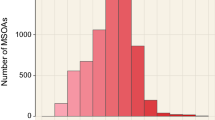Abstract
The problem is not uncertainty—proposed here as an inevitable condition—but the chimera of certainty asserted by most contemporary researchers. Problems of data definition, collection, and their use are reviewed in terms of spatial epidemiology and health data with examples drawn from several areas of contemporary health research. The argument is that preconceptions limit data modeled in a manner assuming its completeness. The result, as the West Nile Virus example seeks to demonstrate, may obscure other patterns and limit avenues of research.






Similar content being viewed by others
References
Arbia G, Griffith D, Haining R (1998) Error propagation modeling in raster GIS: overlay operations. Int J Geogr Inf Sci 12(2):145–167
Blackwell T (2006) Superbugs passed to people by pets. National Post (21 February), A1
CDC (2000) Guidelines for surveillance, prevention, and control of West Nile virus infection. MMWR 200; 42: Atlanta, Centers for Disease Control and Prevention, pp 25–28
Cooke WH, Grala K, Wallis RC (2006) Avian GIS models signal human risk for West Nile virus in Mississippi. Int J Health Geogr, 5:36. Accessed 18 Dec 2006 at http://www.ij-healthgeographics.com/content/5/1/36
DeCola L (2002) Spatial forecasting of disease risk and uncertainty. Cartogr Geogr Inf Sci 29(4):363–380
Elliott P, Wartenberg D (2004) Spatial epidemiology: current approaches and future challenges. Environ Health Perspect 112(9):998–1006
Farber C (2006) Out of control: AIDS and the corruption of medical science. Harpers Mag 312(1870):37–52
Gibbons RD, Meltzer D, Duan N et al (2000) Waiting for organ transplantation. Science 287:237–238
Goodchild MF (1998) Uncertainty: the achilles heel of GIS? Geo Info Systems 8(11):40–42
Gould P (2006) Sources of error in a map series, or, science as a socially negotiated enterprise. Cartographic perspectives commemorative issue, pp 21–28
Gould P (1983) Is Statistix inferens the geographical name for a wild goose? Econ Geogr 46:439–448
Haggett P (1994) Geographical aspects of the emergence of infectious diseases. Geogr Ann 76B(2):91–104
Institute of Medicine (IOM) (1999) Committee on organ procedure and transplant policy. Organ procurement and transplantation: assessing current polices and the potential impact of the DHHS final rule. Institute of Medicine, Washington
Koch T (2005) Cartographies of disease: maps, mapping, and medicine. ESRI Press, Redlands
Koch T (2001) Scarce goods: justice, fairness, and organ transplantation. Praeger Books, Westport
Koch T (1999) They might as well be in Bolivia: race, ethnicity and the problem of solid organ donation. Theor Med Bioeth 20(6):563–474
Krygier J, Wood D (2005) Making maps: a visual guide to map design for GIS. Guilford, NY
NOTA (National Organ Transplant Act) (1984) Pub. L. No. 98–507; 98 Stat. 2339
Oppenshaw S (1984) The modifiable area unit problem. Geo Books, Norwich
Ostlund EN (2001) Equine West Nile Encephalitis, United States. Emerging Infectious Diseases 7(4). Accessed 14 August 2005: http://www.cdc.gov/ncidod/eid/vol7no4/kmoar.htm
Rappole JH, Derrickson SR, Hubálek Z (2000) Migratory birds and spread of West Nile Virus in the Western Hemisphere. Emerging infectious diseases 6:4. Accessed 20 March 2005 at http://www.cdc.gov/ncidod/eid/vol6no4/rappole.htm
Rothman KJ (2002) Epidemiology: an introduction. Oxford University Press, USA
Selvin S, Merrill DW, Edrmann C, White M, Ragland K (1998) Breast cancer detection: maps of 2 San Francisco Bay area counties. Am J Public Health 88(8):1186–1192
Selvin S, Schulman J, Merrill DW (1992) Distance and risk measure for the analysis of spatial data: a study of childhood cancers. Soc Sci Med 34(7):769–777
Shalala D (2001) Letter from secretary of health and human services to members of congress, February, 1998. In: Koch T (ed) Scarce goods: justice, fairness, and organ transplantation. Praeger Books, Westport
Snow J (1855) On the mode of communication of Cholera. 2nd edn. Churchill, London
Spielman A, D’Antonio M (2001) Mosquito: a natural history of our most persistent and deadly foe. Hyperion, HY, pp 184–202
Turnbull D (2000) Making malaria curable. In: Turnbull D (ed) Masons, tricksters, and cartographers. Harwood Academic, Amsterdam, pp 161–182
Verghese A (1995) My own country: a doctor’s story. Vintage Books, NY
Verghese A, Berk SL, Sarubbi F (1989) Urbes in rure: human immunodeficiency virus infections in rural Tennessee. J Infect Dis 160(6):1051–1055
Wallace R, Wallace D (1995) US apartheid and the spread of AIDS to the suburbs: a multi-city analysis of the political economy of spatial epidemic threshold. Soc Sci Med 41(3):333–345
Wilson ME (1995) Travel and the emergence of infectious diseases. Emerg Infect Dis 1(2):39–46
Acknowledgment
The authors wish to thank reviewers of an earlier draft of this manuscript for their suggestions and comments. We believe their contributions improved significantly the resulting paper.
Author information
Authors and Affiliations
Corresponding author
Rights and permissions
About this article
Cite this article
Koch, T., Denike, K. Certainty, uncertainty, and the spatiality of disease: a West Nile Virus example. Stoch Environ Res Risk Assess 21, 523–531 (2007). https://doi.org/10.1007/s00477-007-0144-z
Published:
Issue Date:
DOI: https://doi.org/10.1007/s00477-007-0144-z




